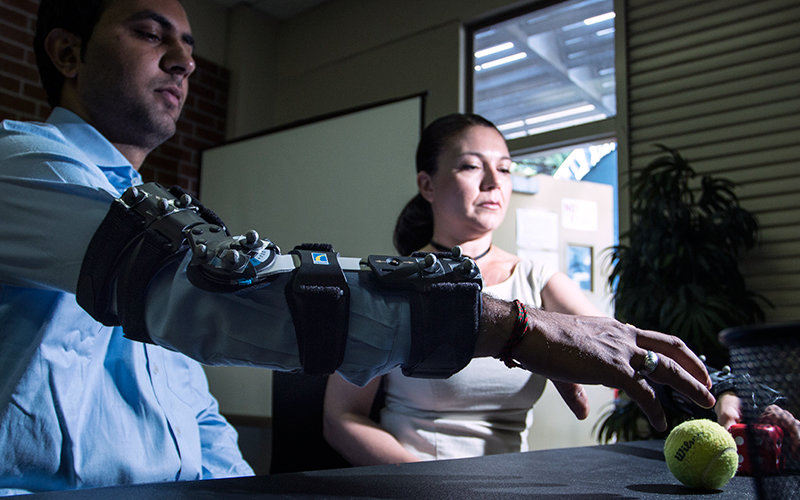
Inside Cal State Fullerton’s Human Interactive Robotics (HIR) Lab, mechanical engineering faculty member Nina Robson and her students are working on novel research to help patients suffering from limb mobility, due to strokes, birth defects or accidents.
The project, led by Robson, is a collaboration between CSUF, Texas A&M University and Idaho State University, and is funded by a National Science Foundation grant.
The main goal of the research is to develop a cost-effective wearable device, similar to robotic glasses, dubbed ARWED, which could be used by post-stroke patients at home.
“It creates a virtual-reality environment to help rehabilitate the patients with upper-limb limitations,” said Robson, assistant professor of mechanical engineering and director of the HIR Lab. “The system will allow the user to perceive the prosthetic or rehabilitation device as part of their upper limb, ‘tricking’ the patient to think of the affected limb as healthy.”
The idea of the research project is based on the discovery more than a decade ago of the “mirror neuron,” which is a type of brain cell that has revealed humans’ ability to learn through action imitation and action observation. The ARWED (Augmented Reality Wearable Robotic Device) will perform a symmetric reflection and real-time mapping of the stroke patient’s healthy limb onto the patient’s most affected limb, Robson explained.
“Researchers have started to conceptualize how the mirror neuron system may benefit recovery of function after stroke, enhance clinical training protocols and lead to a patient’s ability to return to routine daily activities without assistance,” she said.
This summer, Robson’s mechanical engineering graduate students worked on different focuses of the project. Vishalkumar Ahir has been doing experimental work on mimicking stroke-type movements in healthy populations, trying to solve the problem of how people compensate for reduced mobility in their arm.
“The experiments allow for a consistent analysis of impaired movements under controlled conditions, something not available in a clinical setting,” Robson noted.
Rachel Caballero, another mechanical engineering graduate student, is developing a 3D simplified model of an anatomically correct upper arm that moves in the same way a normal human arm would move.
“I’ve been given the opportunity to become exposed to new and different areas of mechanical engineering that I would not have encountered day to day in my job,” said Caballero, who earned her B.S. in mechanical engineering in 2015 and now works in research and development at an electronics company in Irvine.
“I’m also learning about how the human body moves, as well as the biomedical side of engineering. This makes me a much stronger, well-informed engineer because I can apply what I learned in classes and this project to design products in my job that are more ergonomic for the end user,” Caballero added.
Kenneth “John” Faller, assistant professor of computer engineering, and two summer interns joined the team to work collaboratively on creating photorealistic 3D models of virtual limbs and implementing algorithms for incorporating them within the ARWED environment.
This academic year, Robson and her team will complete the development of physical training protocols with ARWED and begin the experimental testing on healthy individuals, as well as stroke patients.